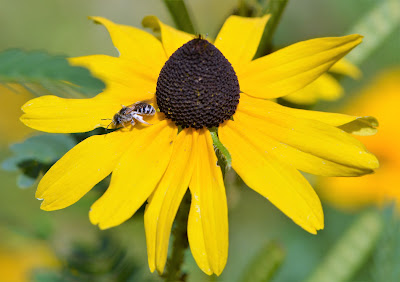Rudbeckia & Goldfinches
The bees and butterflies are dancing on the Rudbeckia hirta come mid-summer. The bees tool around on the dark, central cones gathering pollen and sipping nectar. Leafcutter and bumblebees are who we see most frequently.
Once their work is done, the flowers develop seeds that song birds will devour. This week I noticed the Rudbeckia flowers swaying wildly on a calm July day.
Taking a closer look, I spotted two female American Goldfinches working energetically, pulling seeds from the center cones. The olive toned females blend beautifully with the yellow petals so one doesn't spot them at first glance. The buttery yellow males stand out and are much easier to find. Notice how these birds acrobatically cling to the plant stem while they forage.
The American Goldfinches' diet consists mostly of seeds. Some of their favorite seed flowers include coneflowers, black & brown eyed Susan, Anise hyssop, native thistles, coreopsis, sunflowers, bluestem grass, asters, and goldenrod. They will also eat seeds from elm, birch and alder trees and the buds of conifer trees.
Mid-summer is arduous for goldfinches. Finding food can be a challenge as spring blooming plant seeds (dandelions are a favorite) are long gone and many summer and fall flowers haven't set seed yet. To a limited extent these birds will eat insects in summer. Tip: In your kitchen garden, let your cool season lettuce go to seed. Goldfinches love them! You can also put up a thistle feeder for them during the summer but if you want birds to find their own food you will need to have plants that provide seeds all year.
To make life even more challenging, July and August is nesting season for goldfinches. Unlike many other song birds that feed insects to their brood, goldfinches feed regurgitated seed matter to their young. Goldfinches nest only once a season. They prefer open 'weedy' areas with shrubby perimeters, where they can build their nests in dense shrubs, sometimes trees, using milkweed and thistle down, fibers and spider webs. Goldfinches are not cavity nesting birds [they won't use birdhouses] so providing the right habitat is critical to their success.
The American Goldfinches are year-round residents in our garden and it's important for us to have plants in our garden that provide them with a constant source of food. This is just another reason why I love summer blooming flowers in the Asteraceae family. All too often, we only think of supporting birds with spent flowers in our fall and winter gardens, but granivorous birds need those seeds in summer too. Take a look around your garden. Do you have plants for forage and nesting materials to keep these song birds thriving?






.png)
